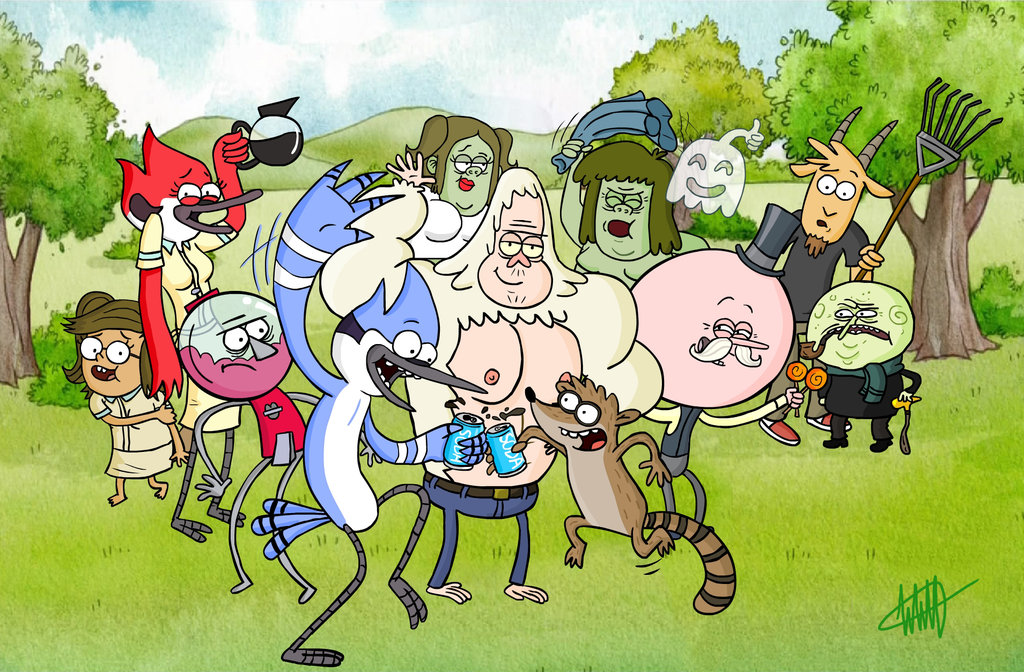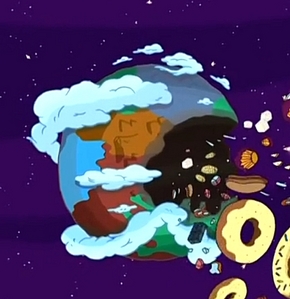Algebraic!: The Best Cartoons for the Thinking Adult
 |
| Characters from Regular Show |
I’m not sure when the cartoon revolution started, but it’s
here and I'm excited. Pixar and Disney are now slipping subtle adult
jokes into children’s films (“Do you think he’s compensating for something?”
–Shrek) to the delight and relief of (bored) parents and adult movie-goers
everywhere. Once upon a time, cartoons were for children, but today they have a
mixed audience. I now spend my weekends watching the cartoon network—and not
just to experience the nostalgia of childhood simplicity. These contemporary cartoons
are actually pretty smart. And, in some cases, they’re also very adult. So, if
you’re interested in becoming a cartoon buff, I’ve provided you with my
favourites below.
Adventure Time (a.k.a. AT)
Genre: Post-Apocalyptic, Adventure
Target Audience: Older children and Young
teens (and probably stoners)
Any time I have a chance to sing
the praises of Adventure Time, I do. At first, this show was of no interest to
me, but a friend of mine casually mentioned that it’s actually a
post-apocalyptic narrative and I had to check it out. I mean, what sort of
children’s show is post-apocalyptic*? If you’re an observant viewer, you’ll
notice that the opening sequence of AT hints at this fact. Among a pile of
random objects (a ring, a broken tv set, headphones), a disembodied arm hangs
from a spidery tree. If you look closer still, you’ll also spot several
undetonated nuclear bombs (yup, this is a kid’s show). Later in the series,
you’ll get to see a shot of the earth from space—and you’ll discover that a
huge chunk of it is missing. The characters occasionally mention a “great mushroom
war,” prompting speculators to suggest that the post-apocalyptic event took
place after a global nuclear war. It’s no mistake that the opening song
specifies Finn’s species, either: he’s the only human left.

AT is worth a watch simply because
it sporadically explores the nature of the catastrophic event that ended the
world as we know it. Additionally, it’s quite philosophical for a cartoon. AT
questions the ethics of cloning, genocide for the greater good, capitalism,
and war, among many other adult topics. In its randomness, it also manages to
be incredibly funny. BMO, Jake, Lemon Grab/Squeeze, and Ice King are some of
the most interesting characters with some of the best lines. All in all, this
cartoon is not just one of my top programs for children, but also one of the
top for adults.
*As it turns out, quite a few. Pokemon and The Flintstones,
for example, are rumored to be a post-apocalyptic narratives as well. Go
figure.
Clone High
Genre: Teen drama (with a twist)
Target Audience: Teens and Young Adults
In this cartoon, genius scientists dig up
famous guys and ladies and make amusing genetic copies: Abe Lincoln, JFK, Cleopatra,
Joan of Arc, and Gandhi. Then, shadowy government figures send those same teenaged
clones to high school. The premise itself is funny and creative and it only
gets better. Clone High is riddled with guest stars, including Jack Black,
Marilyn Manson, and Mandy Moore. Every episode is bizarre, fantastical, and
hilarious in its own way and serves as a satirical and cynical imitation of teen
drama (think Dawson’s Creek and Degrassi). The characters throw parties (with
alcohol free booze); delve into the seedy world of drugs (their drug of choice
is raisins); and go to prom (along with the deformed clone of Marie Curie).
On the surface, Clone High doesn’t seem to
take itself too seriously, but it’s distinctly adult. Firstly, Clone High
requires viewers to have a solid grounding in history—the jokes aren’t always
obvious otherwise. Secondly, there are moments of restrained profoundness. While
the show is mostly concerned with the shallow worries of high school students,
the viewers are occasionally reminded that these clones are part of some awful
experiment and have a direct link to the suffering and
tragedies experienced by their originals. The soundtrack, mostly composed by
the Abandoned Pools, reinforces the melancholy nature of Clone High. Indeed, it
helps set the tone of each episode—particularly the last scene of the last
episode which reveals the hellish fate of these lovable clones.
Sadly, Clone
High was cancelled after its first season and so, the finale’s shock ending
remains painfully unresolved.
Regular Show
Genre: Monster-of-the-week (sort of)
Target Audience: Young and late teens, young
adults, and stoners
Regular Show is like nothing I’ve ever seen
before. A hybrid of The Bugs Bunny Show and Undeclared, the show revolves
around the daily adventures of protagonists, Rigby and Mordecai. Rigby and
Mordecai are humanized animals (I think Mordecai is a blue bird, but I’m unsure
about Rigby) who are probably in their early 20s. Needless to say, they represent
the X generation well in that they’re both underemployed and apathetic. They
spend their days (barely) working at this hellish park—I’m half convinced they’re
stuck in limbo—in the middle of a nameless city. Their boss is a gum ball
machine. The park’s repairman is a giant white ape, Skips, who, as his name
suggests, skips everywhere.
Regular Show includes fantastical elements
each episode, usually in the shape of some sort of monster or mystical creature
which Rigby and Mordecai then must defeat. Some notable monsters include a
cyborg virus, a video game villain, and a movie-loving gnome. Perhaps the most
interesting aspect of this cartoon is the fact that many of the characters are
immortal, suggesting, once again, that Rigby and Mordecai may in fact be stuck
in purgatory. That would explain all the unusual happenings at what looks to be
a normal park. Regardless of the validity of my theory, you’ll surely be
intrigued and entertained while watching this not-so Regular Show.


Comments
Post a Comment